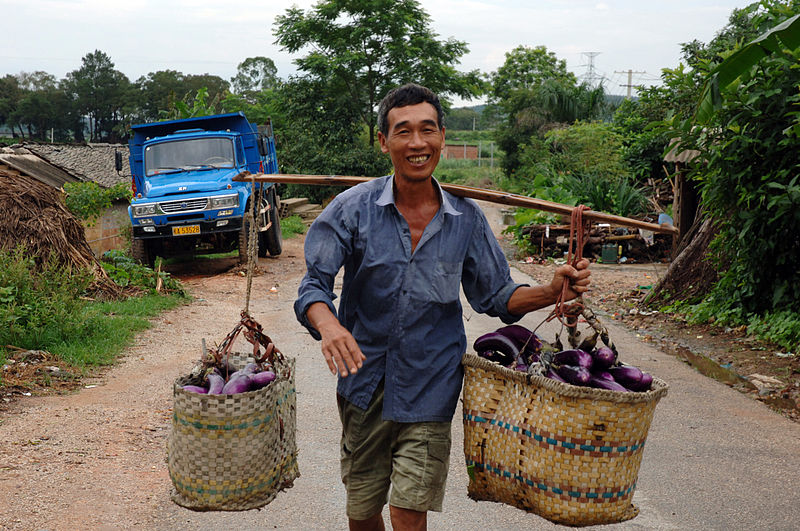China Session: State of the Industry and Ways Forward

Rural developement in and around the outskirts of Nanning in Southern China. China 2006. Photo: Lorrie Graham / AusAID. From Wikimedia Commons.
9:00 to 10:30 CST: In this morning’s Plenary Session at the 2014 Asia Microfinance Forum, we heard leading officials and experts in Chinese microfinance describe programs, regulations and concerns within the national finance industry in China. Speakers discussed how the goals of financial inclusion are being addressed by government officials, microfinance institutions and related organizations.
Microfinance investment opportunities in China were addressed during this panel, as well as how stakeholder partnerships, peer to peer lending and innovation in Chinese microfinance practice offer improved financial services to the poor.
Moderator Mr. Wang Zingzui, Vice President of the China Foundation for Poverty Alleviation (CFPA) began the session, talking about the boom in commercial microfinance in China. P2P platforms are developing quickly in China, he said – and that the Chinese way of going about microfinance is different from the international one.
However, issues in the Chinese sector remain: “The problem is that there is no legal framework or policy environment for microfinance, or there is only one regulatory environment for different types of microfinance,” he said, calling this the “key obstacle” to development of the sector.
Why the lag? Mr. Zingzui said he felt that China’s well-developed banking sector has helped hinder its microfinance sector from developing to the same extent as nations such as China and Cambodia.
The first panelist to speak was Mr. Zhou Hongwen, from the State Consul Poverty Alleviation Office of China, said that over 662 million have been reduced from poverty in China in recent years. In 2013, he said, various departments of the State Consul Poverty Alleviation Office issued guidelines for poverty alleviation and the development of financial services – requiring them to combine policy, commercial, and cooperative finance, increasing credit support for poverty-stricken areas.
Per Mr. Hongwen, the Chinese national government has supported efforts to help poor individuals become self-employed and increase agricultural production, calling microcredit “a great support for our poverty alleviation work” in this sector. The Poverty Alleviation Office has recently issued guidelines that will address innovation in poverty, including microcredit.
“Although we have achieved great success in poverty alleviation, there is still a large gap between cities and rural areas and different groups,” said Mr. Hongwen, describing a “fragile ecology” that still contains many challenges. “We are very willing to cooperate with international organizations at AMF to help improve people’s lives in poor areas,” he said.
Next to speak was Mr. Bai Chengyu, Secretary General of the China Association of Microfinance (CAM), who discussed issues surrounding financial inclusion in China. Mr. Chengyu in his talk described China’s “double dual financial sectors,” in which farmers and MSMEs are excluded by regulated financial sectors. There are two pricing systems, he said, creating a huge shadow banking system – which inspires financial innovation, but also entails huge risks.
Sixty percent of savings in rural households and 10 percent of loans go to rural households in agriculture towards the Western region of China, caused by systematic barriers that vary from location to location, such as differing household registration systems, different social welfare systems, different education systems, and other issues. Due to higher risk and higher cost, it’s hard for banks to provide services to rural areas.
Per Mr. Chengyu, there are about 50,000 large state owned enterprises and around 10 million SMEs, with an estimated 300 million micro entrepreneurs, urban low income, and farmer households. However, regulated financial institutions provide over 76 trillion in yuan that primarily covers only large institutions and SMEs, with the informal lending covering the poor, and shadow banking covering the middle region. “As a result, most financial resources are input into the APAC, the large enterprises,” said Mr. Chengyu, describing the market and systematic barriers that create this dynamic. “Very few aggregate to the bottom.”
There are also two pricing markets caused by financial repression, which Mr. Chengyu said helps to stimulate China’s robust shadow banking system. The shadow banking system supports SMEs with services such as trust companies, guarantee companies, P2P lending, and other innovations – pushing the banks and regulators to create reform.
But there are negative impacts as well, said Mr. Chengyu. The shadow banking system is unregulated and thus out of control, incurring risk. “Our task is to do some reform and regulation to remove the barriers between the market segments,” said Mr. Chengyu, so money can permeate the very bottom of the market, just not the top and middle.
China is developing new policies and regulations for developing the financial sector, an effort that includes promoting new financial innovations, such as Internet financing, P2P lending platforms, electronic payment platforms, crowd funding platforms, and other digital services. Now, the government is working to create village banking systems, said Mr. Chengyu, including a village self hep credit fund – creating a financial cooperative.
What lies ahead for the future of China’s microfinance sector? The future includes the increasing incorporation of digital technology into the microfinance industry, including small personal databases and the so-called “Internet of things” – creating a modern financial inclusion system.
Third to speak was Mr. He Guangwen, Professor and Doctoral Tutor at the China Agricultural Industry, who spoke on the opportunities and challenges faced by the microfinance sector in China. “The economy is booming, and the demand for microfinance is huge – the market is huge,” he said. “How can we evaluate the MFI market, and what’s the challenge and opportunity?”
There are about 249 million farming households in China, said Mr. Guangwen, with about 50 million MSEs, two groups that create the primary demand for MFIs, he said. There are also more and more cooperatives, to the tune of about 1 million – fostering yet more demand for microcredit services. Finally, the government wishes to improve the market in two aspects: by improving microfinance institutions, and introducing tax benefits to stimulate banks towards the microfinance market.
“Now, there are more and more so called new financial institutions coming to the market,” said Mr. Guangwen, looking at institutions such as village and township banks, which number 1092, formal rural mutual fund associations, of which there are 49, and MCCs, of which the bank has invested in 14 institutions.
Mr. Guangwen spoke of the diversity of the Chinese microfinance sector, including institutions such as microcredit companies, mutual fund associations, pawn shops, NGO microfinance organizations, microcredit guarantee centers for the re-employment of laid-off workers, and numerous other players. He also described institutions such as prudential and non-prudential registered MFIs, which are joined in the Chinese sector by professional microcredit institutions, NGO MFIs, a booming P2P sector, and policy-based MFIs.
What are the challenges to the Chinese MFI market? First, banks must find ways to cover less developed, rural, and remote areas more effectively, a pertinent concern especially in Western China, noted Mr. Guangwen. They must also find ways to serve clients without the usage of collateral, and build self-organizational MF business mechanisms.
Last to speak was Ms. Jiawei Sun, General Manager of the Microfinance R&D Center at Harbin Bank. Per Ms. Sun, Harbin Bank has been incorporated since 1997, and covers 14 provinces and cities, with a total asset of 322.1 billion yuan. The bank won the award of China Best Bank for MSE Microfinance Services by an Asian Banker, and had a 73.1 billion yuan small lending balance by the end of 2013. In 2014, in a major achievement, the bank was listed on the Ninpo Market of the Hong Kong stock exchange.
What are Harbin Bank’s activities in small lending business development? Since 2006, said Ms. Sun, the total disbursement of MSME’s lending service was 107.4 billion yuan. The bank has also moved into the rural finance sector, the first Chinese city commercial bank to launch these services, services that now cover over 7,300 Chinese villages and 1.6 million customers. The bank has constructed over 1,000 e-outlets for its clients, with numerous transactions.
“Through our long time practice and exploration, Harbin Bank has developed small lending know-how and technology suited to China’s conditions,” said Ms. Sun of the bank’s particular expertise in this arena, and now holds its own intellectual property ranks. It provides consulting services on these topics to other banks that wish to improve their expertise in the sector, extending its help to over 20 financial institutions in multiple regions of the country.
In addition, Harbin Bank has recently engaged in small industry lending benchmark research, which is now supported by numerous institutions and Chinese governmental ministries.
“We are very glad to see that Chinese small lending has become an important part of global microfinance,” Ms. Sun said, describing Harbin Bank’s long-term goals of becoming an international authority in the microfinance sector. “Let’s work together to realize our goals of financial inclusion,” she said.
This session was facilitated by CFPA Microfinance – CFPA’s Microfinance Group was established in 1996, and has evolved into an organization (CFPA Microfinance Management Ltd.) that both provides microcredit loans and runs practical training and information workshops to encourage sustainable development.
CFPA’s microfinance project has 3 main objectives: to provide loans to the poor, improve the poor’s capacity for self-reliance and self-development, and achieve operational and financial sustainability.





